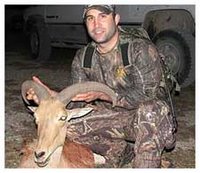Hunting Tips, Questions, Stories & Discussion
Focusing on managing Texas wildlife habitat and natural resources for native and exotic wild game species, for this and future generation of hunters and outdoor enthusiasts.Monday, December 29, 2008
What makes hunting an Aoudad Sheep so challenging?
 If you are used to hunting from a blind or from a stand, hunting Aoudad sheep can be a whole different ball game. These sheep are much more leery of humans, simply by nature, than are typical native North American deer species. One of the major differences is that the Aoudad relies much more on visual acuity, but also has an amazing sense of smell. Combining these two features really makes this species a true hunting challenge.
If you are used to hunting from a blind or from a stand, hunting Aoudad sheep can be a whole different ball game. These sheep are much more leery of humans, simply by nature, than are typical native North American deer species. One of the major differences is that the Aoudad relies much more on visual acuity, but also has an amazing sense of smell. Combining these two features really makes this species a true hunting challenge.One other peculiarity of the Barbary sheep is that they will always run when they sense danger approaching, however if the danger seems very close they immediately freeze. This freezing can make them very hard to distinguish, especially on the rocky and rather desolate terrain they prefer.
In their native land of Africa hunting an Aoudad is seen as a true test of manhood and it is not an easy process, even for hunters with years of experience. It is this very trait that first attracted North American sportsman to the species. Because Aoudad Sheep do not shed their horns, they can be and are hunted year round.
How many Aoudad Sheep are in Texas?
Since the mid 1960’s the Aoudad sheep population has expanded within the state and even into surrounding and neighboring states. The original few pairs that were imported by Texans stationed in Africa in World War ll simply couldn’t be fenced in and escaped to live in the wild areas of central and southwestern Texas. The living conditions were comparable temperature wise to their native land, but food was much more plentiful. This combination lead to a rapid expansion of the population both in the wild and now on game ranches. It is estimated that there are approximately 25,000 Aoudad sheep now in the state, with more throughout New Mexico. Since these sheep are largely living in small groups throughout some of the roughest terrain in the state, total populations are only an estimate rather than a hard number.
Labels: aoudad sheep hunting, barbary sheep hunts, exotic game hunt
Archives
December 2008 January 2009 February 2009 April 2009 May 2009 June 2009 July 2009 August 2009 September 2009 November 2009 December 2009 January 2010 February 2010 March 2010 April 2010
Subscribe to Posts [Atom]
